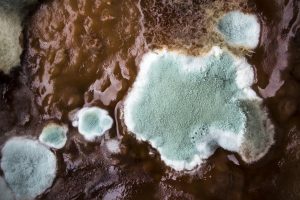Print a Sign-In Sheet | Spanish Version Coming Soon
Molds can grow on almost any material and is the most common form of fungi. Mold needs moisture and oxygen to thrive, and it reproduces through spores.
A spore is a microscopic cell that is resistant to drying and is released into the air. Airborne mold spores can be found both indoors and outdoors. The spores will start growing on the contaminated surface and release chemicals that basically digest and eventually destroy the surface and underlying materials.
Unfortunately, some molds may cause health problems. The health effects can range from mild to severe in sensitive individuals when enough airborne spores are inhaled. They affect people differently, as some individuals are more sensitive to mold than others. Please see below for information about mold and tips to prevent it.
Potential Health Effects
- Sneezing.
- Runny nose.
- Eye irritation.
- Cough.
- Aggravation of asthma.
- Dermatitis.
Individuals at Greatest Risk
- Infants.
- Children.
- Elderly.
- People with underlying health conditions:
- Persons with allergies or existing respiratory conditions like asthma, sinusitis, or other lung diseases.
- Persons with a weakened immune system.
- Persons who have undergone recent organ or bone marrow transplants.
- Persons recovering from recent surgery.
- Persons receiving chemotherapy or long-term steroid treatment.
Recognizing Mold
- Appears as distinctly colored woolly mats.
- Mildew is black and is one of the most common forms of mold.
- Produces a foul odor, musty, or earthy smell.
Preventing Mold
- Control moisture, as mold cannot grow without it.
- Use a wet-dry vacuum to dry out buildings/surfaces (best within 24 to 48 hours).
- Use a dehumidifier.
- Use fans to help dry areas/surfaces.
- Clean wet surfaces/materials with a detergent and water.
- Dispose of all water-damaged materials.
- Dispose of all materials visibly contaminated with mold.
- Remove and dispose of all porous materials that have been wet for more than 48 hours:
- Carpeting.
- Carpet padding.
- Upholstery.
- Wallpaper.
- Drywall.
- Floor and ceiling tiles.
- Insulation.
- Clothing.
- Leather.
- Paper and wood.
- Food.
Mold Cleanup
- Consider obtaining the services of a professional mold remediation company.
- Working areas should be well-ventilated.
- Put mold-damaged materials in sealed plastic bags for disposal.
- Clean mold off hard surfaces and other nonporous materials with detergent and water and allow it to dry completely.
- Disinfect the cleaned surfaces with a household bleach solution:
- ¼ cup bleach per 1 gallon of clean water for light contamination.
- 1 ½ cups bleach per 1 gallon of clean water for heavy contamination.
- Do not mix bleach with other cleaning products, especially ones containing ammonia.
- Consult the safety data sheet (SDS) for bleach.
- Use appropriate personal protective equipment (PPE)
- Avoid breathing mold spores.
- Use an N-95 respirator.
- Avoid touching mold with bare hands:
- Use long gloves that extend to the middle of the forearm.
- Use gloves made from natural rubber, neoprene, nitrile, polyurethane, or PVC.
- Avoid getting mold spores in your eyes:
- Use goggles without ventilation holes.
KEMI does not assume liability for the content of information contained herein. Safety and health remain your responsibility. This information is to be used for informational purposes only and not intended to be exhaustive or a substitute for proper training, supervision, or manufacturers’ instructions/recommendations. KEMI, by publication of this information, does not assume liability for damage or injury arising from reliance upon it. Compliance with this information is not a guarantee or warranty that you will be in conformity with any laws or regulations nor does it ensure the absolute safety of any person, place, or object, including, but not limited to, you, your occupation, employees, customers, or place of business.

